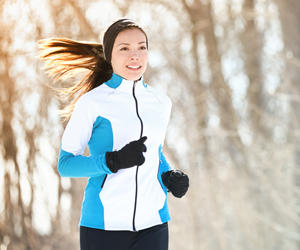Be smart, stay safe and know your limits for winter exercise
Even though some days the weather outside is frightful, Earth Day weekend (April 21-22) is approaching quickly and may catch you off guard.
Whether you are training for an event or if you’re just trying to be healthier in 2017 — exercising outdoors this time of year is a great way to beat the winter blues. To be prepared and smart about exercising outdoors and to have a safe and effective workout, keep these tips in mind.
- Know your own limits. You probably don’t need to be reminded that Minnesota winters can be very unforgiving. As with any exercise program, check with your physician before beginning, especially if you have any underlying health conditions. For those who are getting over colds or illnesses, don’t rush back into action. Not allowing yourself to fully recover from a sickness can make the recovery process even longer. It is important to acknowledge that there are just certain days where the weather is too cold or blustery and there’s little upside to venturing outdoors. For these days, head to the gym or exercise at home to get your workout in.
- Dress warmly, but don’t overdress. Exercise generates a considerable amount of heat — enough to make you feel like it’s much warmer than it really is. Dress in layers that you can remove as soon as you start to sweat but can put back on if you start to feel cold. Start with a thin base layer of moisture wicking material (damp clothes can increase heat loss). Cotton should be avoided as a base layer, as it tends to hold moisture and stay wet next to your skin. The next layer should provide more insulation, such as fleece or wool. The outer layer should be waterproof (or water resistant) and breathable. It may be beneficial to experiment to find the right combination for you and your exercise habits.
- Don’t forget about your head, hands and feet. Being most vulnerable, your nose, ears and fingers are often the first to get cold. Similar to the base layer you wear on your body, wear a pair of thin moisture-wicking gloves underneath a heavier pair of gloves or mittens. The same goes for your feet, thin moisture wicking sock underneath a wool sock. You may want to consider buying your exercise shoes a half size larger to accommodate for the larger sock volume. A synthetic hat with a scarf, balaclava or neck muffler is recommended to provide protection and warmth for your head.
- Make yourself visible. Due to the limited amount of daylight in the winter, you will be more likely to be exercising in reduced visibility. Wear bright reflective clothing and carry a light (either a flashlight or headlamp). Remember to go against the flow of traffic if you are walking or running and to go with the flow of traffic if you are riding a bike.
- Hydration. Even though it is cold outside, you will still lose a water through sweat. Remember to have something to drink before, during and after your workout.
- Other things to keep in mind. Snow and ice can make for an interesting workout — don’t worry about how fast or slow you are going. Go at a pace where you feel comfortable and safe. Always look for stable footing if you are walking or running. Snow that’s been packed down with provide better traction. Fresh powder often can cover up ice patches. There are many types of cleats that can be used while running/walking to help with traction. If you can, start your exercise heading into the wind and finish with the wind blowing into your back so you don’t work up a sweat and then turn directly into cold wind.
